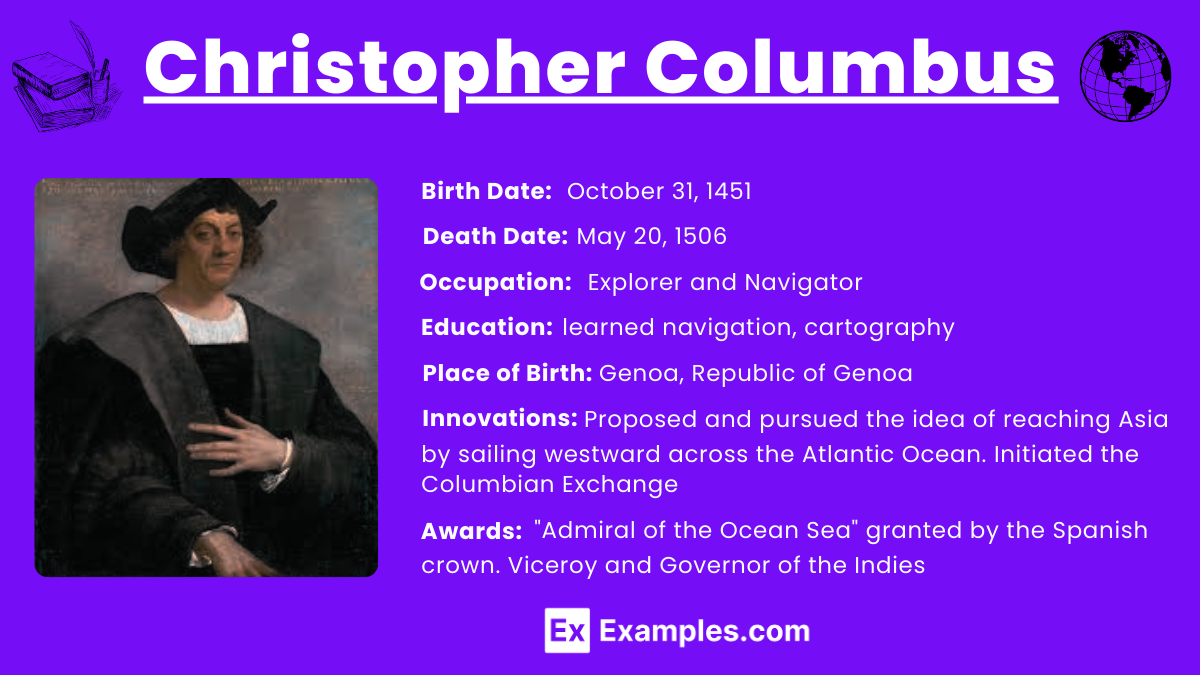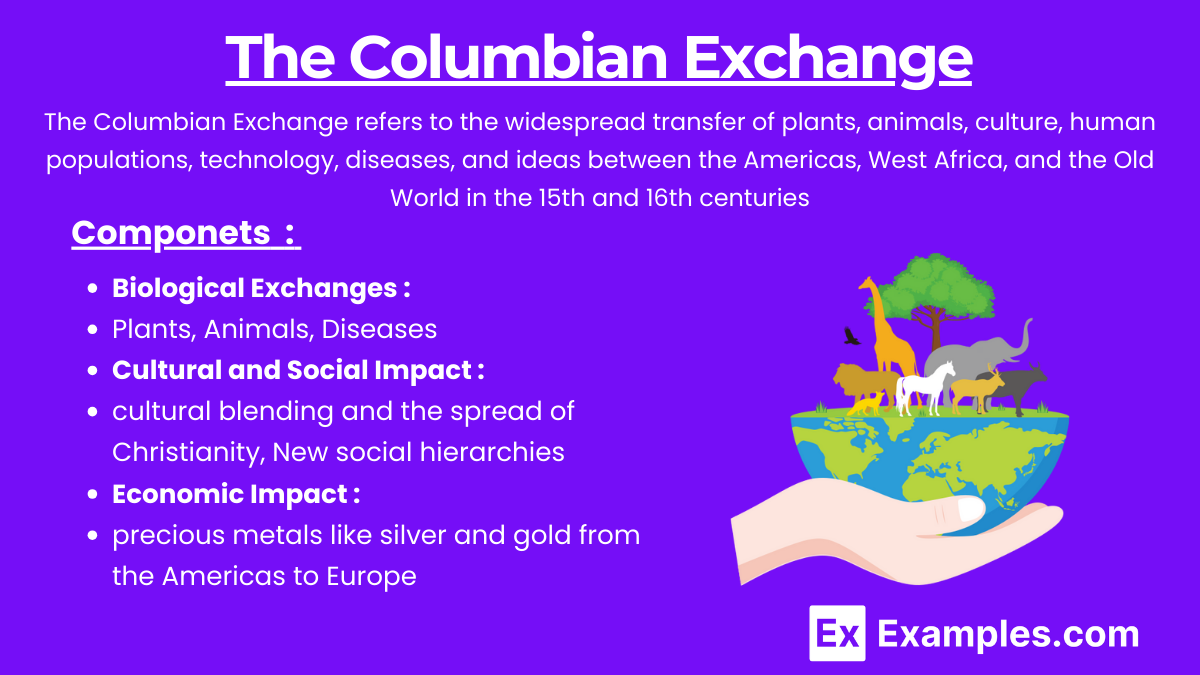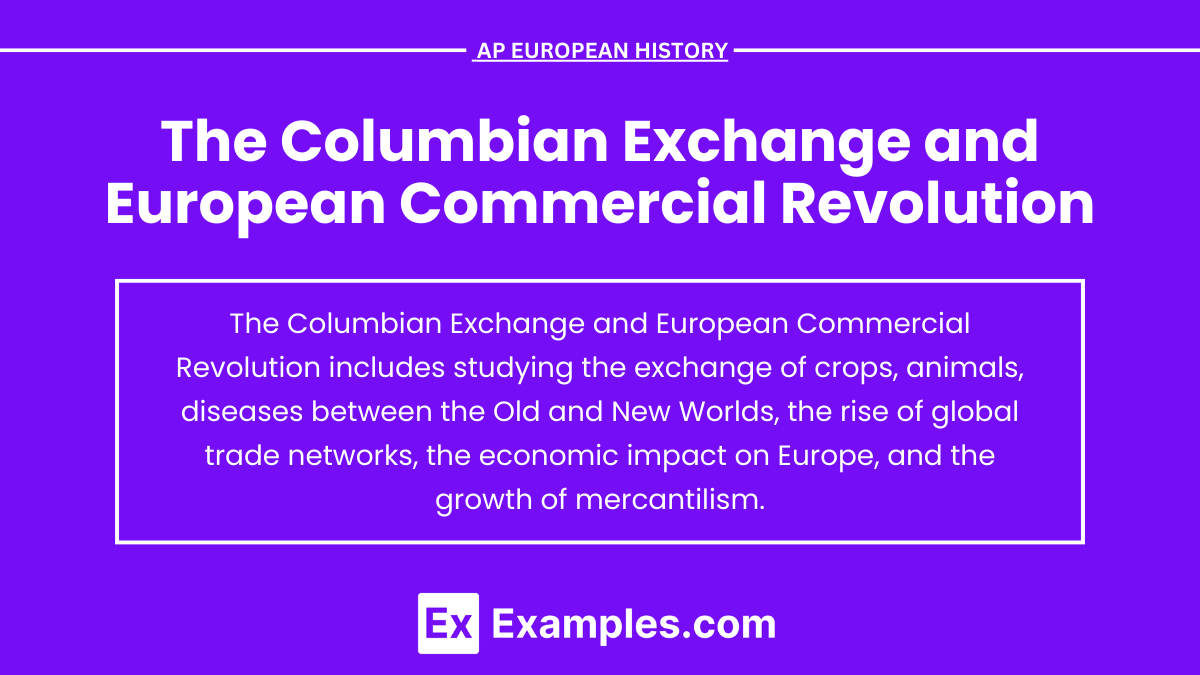The Columbian Exchange and the European Commercial Revolution were transformative events from the 15th to 18th centuries that reshaped global economies and societies. The Columbian Exchange involved the transfer of plants, animals, and diseases between the Old and New Worlds, leading to significant cultural and demographic shifts. Concurrently, the European Commercial Revolution marked the rise of capitalism, expanded trade networks, and financial institutions, fundamentally altering economic structures and international relations. These developments laid the foundation for the modern global economy.
Learning Objectives
For the AP European History exam, you should learn the causes and impacts of the Columbian Exchange and the European Commercial Revolution. Understand the exchange of crops, animals, and diseases between the Old and New Worlds, and its effects on global populations and cultures. Study the rise of capitalism, the expansion of trade networks, and the development of financial institutions. Grasp the significance of mercantilism and how these factors led to economic and social transformations in Europe and its colonies.
Introduction of Christopher Columbus

Christopher Columbus, born in Genoa, Italy, October 31 in 1451, was an explorer and navigator whose voyages significantly shaped the course of history. In 1492, Columbus sailed westward under the Spanish crown's patronage, seeking a new route to Asia. Instead, he stumbled upon the Americas, landing on an island in the present-day Bahamas. Though he believed he had reached the East Indies, his discovery marked the beginning of European exploration and colonization of the New World, fundamentally altering global trade, culture, and geopolitics.
Columbus's legacy is complex and multifaceted. On one hand, his expeditions opened the Americas to European settlement, leading to the exchange of goods, ideas, and cultures known as the Columbian Exchange. On the other hand, these voyages also initiated the widespread exploitation and colonization of indigenous populations, leading to profound demographic and cultural disruptions. Columbus made four voyages in total, exploring parts of the Caribbean and Central and South America, but he never fully grasped the scope of his discovery. He died in 1506, unaware that his journeys had paved the way for the era of European exploration that reshaped the world.
The Columbian Exchange

The Columbian Exchange refers to the widespread transfer of plants, animals, culture, human populations, technology, diseases, and ideas between the Americas, West Africa, and the Old World in the 15th and 16th centuries. Named after Christopher Columbus, this exchange profoundly affected the world's history.
Key Aspects of the Columbian Exchange
Biological Exchanges:
Plants: The Americas introduced crops like maize, potatoes, tomatoes, and cacao to Europe. These crops became staple foods in many parts of the world, significantly boosting population growth.
Animals: European settlers brought horses, cattle, pigs, and sheep to the Americas. These animals transformed the agricultural practices and economies of indigenous peoples.
Diseases: Europeans brought diseases such as smallpox, measles, and influenza to the New World. The native populations, having no immunity, suffered catastrophic losses, with estimates suggesting that diseases decimated up to 90% of indigenous populations.
Cultural and Social Impact:
The exchange led to significant cultural blending and the spread of Christianity. European colonization also resulted in the displacement and assimilation of native cultures.
New social hierarchies emerged, often based on race and heritage, as seen in the caste systems of Latin America.
Economic Impact:
The influx of precious metals like silver and gold from the Americas to Europe fueled economic growth and inflation, known as the "Price Revolution."
The European Commercial Revolution

The European Commercial Revolution refers to the period of European economic expansion, colonialism, and mercantilism from the late 15th century to the 18th century. This era was characterized by the expansion of trade routes, the rise of powerful maritime nations, and significant changes in banking and finance.
Key Components of the European Commercial Revolution
Expansion of Trade Routes:
Atlantic Trade: The discovery of the New World and sea routes to Asia via the Cape of Good Hope revolutionized trade. The Atlantic Ocean became a vital trade corridor, linking Europe with Africa, the Americas, and Asia.
Triangular Trade: This system involved the exchange of goods and enslaved people between Europe, Africa, and the Americas. European goods were traded for enslaved Africans, who were then shipped to the Americas. The Americas supplied raw materials and agricultural products back to Europe.
Rise of Merchant and Banking Classes:
The growth of trade led to the emergence of a wealthy merchant class. In cities like Antwerp, Amsterdam, and London, merchants became powerful economic players.
Banking innovations, such as the establishment of joint-stock companies and stock exchanges, facilitated larger-scale trade and investment. The Dutch East India Company and the British East India Company are prime examples of such enterprises.
Mercantilism:
European powers adopted mercantilism, an economic policy aimed at maximizing exports and minimizing imports. Colonies were seen as sources of raw materials and markets for finished goods, supporting the mother country's economic growth.
Tariffs and monopolies were used to control trade and accumulate wealth. The navigation acts in England, for instance, restricted colonial trade to benefit the English economy.
The Intersection of the Columbian Exchange and the Commercial Revolution
The Columbian Exchange and the European Commercial Revolution were interlinked processes that reshaped the global economy. The influx of new crops and wealth from the Americas played a critical role in Europe's economic transformation. The exchange not only fueled population growth and urbanization but also contributed to the rise of European nations as global powers.
Long-Term Impacts
Globalization:
These events laid the foundation for modern globalization, creating interconnected economies and cultures across continents.
Demographic Changes:
The introduction of new crops and the movement of populations led to significant demographic shifts. Europe's population increased, while indigenous populations in the Americas decreased drastically due to disease and conquest.
Economic Inequality:
The economic benefits of the Columbian Exchange and the Commercial Revolution were not evenly distributed. The wealth generated often resulted in increased social inequality, both within Europe and globally.
The Columbian Exchange and the European Commercial Revolution were transformative events that reshaped the world. They not only altered the economic landscape but also had profound social, cultural, and environmental impacts. Understanding these processes is crucial for mastering the AP European History exam, as they are central to the broader narratives of European expansion and global integration.
Examples of the Columbian Exchange and European Commercial Revolution
New World Crops: Potatoes, tomatoes, and maize introduced to Europe, boosting agriculture and population.
Old World Diseases: Smallpox and measles devastated Indigenous populations in the Americas.
Mercantilism: European nations pursued wealth through trade surpluses and colonial expansion.
Transatlantic Slave Trade: Increased African slave labor for plantations in the Americas.
Joint-Stock Companies: Dutch and British East India Companies fostered global trade and investment.
Practice Questions on The Columbian Exchange and European Commercial Revolution
Question 1:Which of the following best describes the impact of the Columbian Exchange on European agriculture?
A) New staple crops like potatoes and maize boosted food production and population growth.
B) Traditional European crops declined due to competition from American crops.
C) European farming adopted American techniques.
D) American crops were unsuitable for European climates.
Answer: A) New staple crops like potatoes and maize boosted food production and population growth.
Explanation: The Columbian Exchange introduced high-yield crops like potatoes and maize, which increased food availability and supported population growth in Europe.
Question 2: How did the European Commercial Revolution contribute to the development of a global economy?
A) Restricted trade to neighboring countries.
B) Established new trade routes and financial institutions.
C) Encouraged European self-sufficiency.
D) Limited use of precious metals in trade.
Answer: B) Established new trade routes and financial institutions.
Explanation: The European Commercial Revolution expanded trade routes and created financial institutions, facilitating global trade and economic integration.
Question 3: What was one significant consequence of the Columbian Exchange on the indigenous populations of the Americas?
A) Population boom due to new food sources.
B) Drastic population decline due to European diseases.
C) Increased agricultural productivity from European techniques.
D) Widespread adoption of European languages.
Answer: B) Drastic population decline due to European diseases.
Explanation: The introduction of diseases like smallpox by Europeans caused significant population losses among indigenous peoples, who had no immunity.


